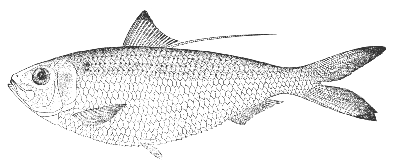Thread herring Opisthonema oglinum (LeSueur) 1817
[Jordan and Evermann, 1896-1900, p. 432.]

Figure 49.—Thread herring (Opisthonema oglinum). Drawing by Louella E. Cable.
Description—
The thread herring is distinguishable at a glance from all the herrings that regularly inhabit the Gulf of Maine by the prolonged last ray (usually about as long as the body is deep) of its dorsal fin. It resembles the gizzard shad of [page 113] fresh and brackish waters farther south in this respect, but the two differ rather conspicuously in various details. In the thread herring, the upper edge of the tail fin is about 1½ times as long as the head (only about as long as the head in the gizzard shad); the point of origin of the dorsal fin is a little in front of the origin of the ventral fins (a little behind in the gizzard shad); the distance from the origin of the ventrals to the origin of the anal fin is at least 1½ times as long as the base of the anal (only about ¾ to 4/5 in the gizzard shad); and the anal fin is very low, with its first few rays a little shorter than the eye (about 1½ times as long as the eye in the "gizzard"). There is no danger of confusing a thread herring with a young tarpon with which it shares the prolonged dorsal ray, for its dorsal fin originates in front of the ventrals, while the two fish are far apart in general appearance. This is a rather thin fish, its body about 2½ to 3 times as long (to the base of the tail) as deep; the belly is sharp and saw edged; the tail deeply forked as in our other herrings. There are 18 to 19 rays in the dorsal fin, 22 to 24 in the anal.
Color—
Bluish above, silvery on sides and belly. The scales along the back have dark centers, forming longitudinal streaks, and there is a faint dark spot just behind the upper margin of the gill cover; the dorsal and caudal fins have black tips.
Size—
Maximum length about 12 inches.
General range—
Atlantic coast of America in tropical and subtropical latitudes, south to Brazil, straying northward to Chesapeake Bay, and occasionally as far as southern Massachusetts.
Occurrence in the Gulf of Maine—
A thread herring is caught off southern New England occasionally; they were even reported as rather common in Buzzards Bay and in Vineyard Sound during the summer of 1885. But there is only one record of it within the Gulf of Maine, a single specimen 7 inches long, taken off Monomoy Point, at the southern angle of Cape Cod, in August 1931.[29] Being a tropical fish, it is not apt to reach the Gulf except as the rarest of strays.